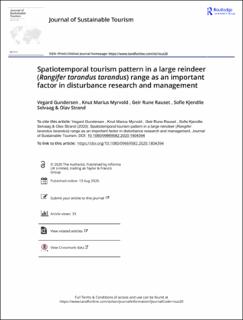| dc.contributor.author | Gundersen, Vegard | |
| dc.contributor.author | Myrvold, Knut Marius | |
| dc.contributor.author | Rauset, Geir Rune | |
| dc.contributor.author | Selvaag, Sofie Kjendlie | |
| dc.contributor.author | Strand, Olav | |
| dc.coverage.spatial | Norway | en_US |
| dc.date.accessioned | 2020-08-21T11:10:37Z | |
| dc.date.available | 2020-08-21T11:10:37Z | |
| dc.date.created | 2020-08-18T12:31:27Z | |
| dc.date.issued | 2020 | |
| dc.identifier.issn | 0966-9582 | |
| dc.identifier.uri | https://hdl.handle.net/11250/2673393 | |
| dc.description.abstract | Tourism and recreation in protected areas may compromise conservation values if their forms and volumes exceed the area’s tolerance. Disturbance-sensitive species such as wild and semi-domestic reindeer (Rangifer tarandus tarandus) in most mountain areas in Fennoscandia are particularly vulnerable to humans, but disturbance research seldom includes data on the human component of this co-existence. By estimating the visitor volume in space and time and visitor characteristics in the largest national park and wild reindeer range in Norway we analyzed reindeer trail crossing propensity and examined the spatial overlap between humans and GPS-collared female reindeer (n¼98) during summer. The data showed that female reindeer herds used areas with overall less human traffic and recreational infrastructure. Reindeer herds started avoiding crossing hiking trails used by more than 10–15 persons per day and avoided crossing trails when visitor volumes exceeded 30–50 persons per day. During the hunting season, the herds were largely dispersed and crossed over trails independent of visitor volume, indicating a collective flight response to hunters. We discuss how including data on human use can further our understanding of ecological effects in disturbance research and how it can improve management interventions for better co-existence between humans and reindeer. | en_US |
| dc.language.iso | eng | en_US |
| dc.rights | Attribution-NonCommercial-NoDerivatives 4.0 Internasjonal | * |
| dc.rights.uri | http://creativecommons.org/licenses/by-nc-nd/4.0/deed.no | * |
| dc.subject | Outdoor recreation | en_US |
| dc.subject | tourism management | en_US |
| dc.subject | wildlife disturbance | en_US |
| dc.subject | coexistence | en_US |
| dc.subject | adaptive management | en_US |
| dc.title | Spatiotemporal tourism pattern in a large reindeer (Rangifer tarandus tarandus) range as an important factor in disturbance research and management | en_US |
| dc.type | Peer reviewed | en_US |
| dc.type | Journal article | en_US |
| dc.description.version | publishedVersion | en_US |
| dc.rights.holder | 2020 The Author(s). | en_US |
| dc.subject.nsi | VDP::Samfunnsgeografi: 290 | en_US |
| dc.subject.nsi | VDP::Human geography: 290 | en_US |
| dc.source.journal | Journal of Sustainable Tourism | en_US |
| dc.identifier.doi | 10.1080/09669582.2020.1804394 | |
| dc.identifier.cristin | 1823810 | |
| cristin.ispublished | true | |
| cristin.fulltext | original | |
| cristin.qualitycode | 1 | |

